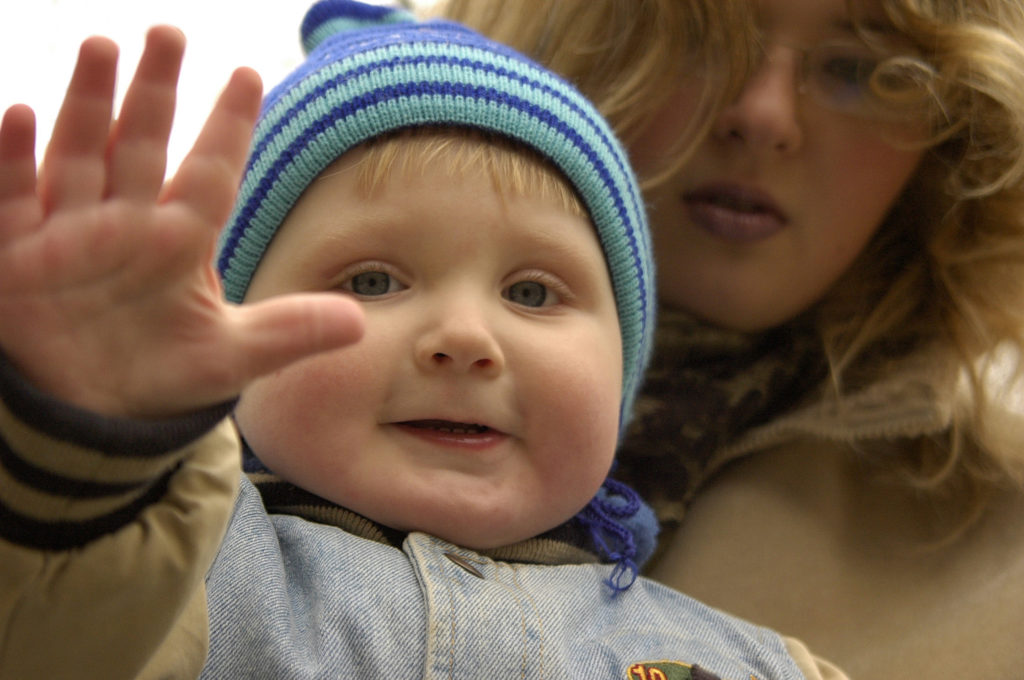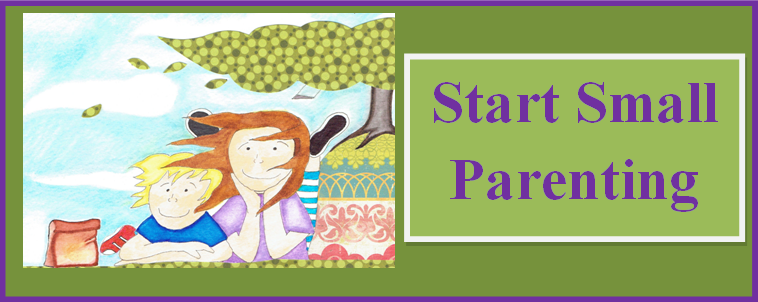
As is expected, children are constantly changing and growing. With change and new experiences can come anxiety and off-track behaviors. More opportunities for independence and freedom can bring up difficulties with separation from the parent.
Fall is the time when many families either start new activities or join a preschool or daycare situation. This is a very exciting time as we are given a glimpse into our child’s independence – and the future but inevitable separation from our day-to-day lives. Yet, saying goodbye and this separation can be tough, creating fear or anxiety – in the child and the parent.
Change Readiness
The unknown can be perplexing for many young children. A new experience occurs and the child often has no warning or preparation. It could be a change in natural development like the end of nursing, sleeping in the child’s own bed, or the start of preschool. It could be something larger like a move, a parent’s divorce, or the addition of a new family member.
Kids in early childhood don’t have a great sense of time. They don’t understand schedules and can’t keep track of the future and what will happen next. This leaves them with a lot of unknowns. Their behavior often reflects their unhappiness with the internal and external changes that are occurring.
Some children have a harder time with change than others, but there is usually some level of difficulty for all kids. A chaotic reaction to change can be very normal. And this chaos can be mitigated. There are ways you can support your child through a change.
As a parent, you schedule, plan, organize, and coordinate the family events. Pay close attention to new or potentially stressful situations for your child. Allow for a balance of Active and Calm. When possible, let your child know that a change is happening.
Here are three steps for Change Readiness.
- Be ready and sure. Your confidence is the key to change. If you are hesitant about shifting something, this will make it more difficult for the child. Either your own hesitancy or the child’s resistance may give you information that it’s not the right time for a change or that the change needs to be supported in another way. When the time for change is right, or change is inevitable, your child looks to your self-reliance and certainty around the change.
- Prepare. Use the Power of Three listed below to help a child make a change, whether it’s behavioral or a new experience. Include the child by giving information – they may only need a sentence or two. Two choices can be helpful. “We’re making a change tonight. I won’t be staying in your bed until you fall asleep but I will stay in the room. Shall I sit in the rocker or lie on the floor?” Practice the change when possible before the change happens. “Let’s go in the bedroom and practice how it will go tonight.”
- Make the Change…and Acknowledge it. Feelings of loss, grief, or unhappiness are normal. Encourage your child that they are normal to have those feelings. Let them know change is difficult and that you can accept their upset feelings.
Power of Three
Provide three opportunities for the child to gain an understanding of what will happen. Space the three out, but don’t let too much time pass. This is part of the child’s preparation when making a change. Here’s how it goes:
Before an event, such as the night before, tell or show your child what is going to happen or what behavior you expect. Tell or show them the morning of or a few hours before the event occurs. Tell or show them just before the event, perhaps as you pull up in the car.
Don’t Overtalk. Be Brief. The act of repetition is helpful. When small children are learning something new, repetition is good. Whenever possible, incorporate different learning styles, such as visuals, movement, or sound.
Check out my blog post, Power of Three, for more on this effective practice.
Separation Readiness
Imagine that you get hired for a new job. You are told you start the next day. No one tells you what time you should show up and when you do, you are led to a desk and told to go to work. There is no explanation, no chance to observe others, and no idea what is expected. Inside, you have a sense of panic that you might really screw up. For some children, this is what the first day of preschool is like.
I often get the question, “Is my child ready for pre-school?” This may be the first time that the parent leaves the child alone somewhere. Sometimes, I am contacted by frantic parents who report that the start of preschool has created chaos in the home. The child’s behavior often reflects her unhappiness with the internal and external changes that are occurring.
In order to have some idea if the child is ready for an independent experience, it’s important to first observe how well the child is doing with other small separations. If the child has never been left at a babysitter’s or grandparents, then she doesn’t yet have practice being with another caregiver. If the child wants to stay close to the parent at the park or music class, then she may need more time before daily separation occurs.
One of the best ways to help a child learn about separation is to give small experiences first before stepping into a scheduled routine of daycare or preschool. It also helps to know about the stages of your child’s development concerning object permanence.
Object permanence. A child’s fear of a parent leaving one’s sight is developmental and first begins with an awareness of object permanence. This mean knowing that an object still exists, even when hidden, and requires the ability to form a mental representation of an object. From 4 – 8 months, infants make no effort to look for a hidden object. There is a lack of object permanence. From 8 – 18 months, infants retrieve hidden objects. From 18 – 24 months, they can remember objects and specific people that are not present. Separation anxiety often goes hand-in-hand with this new intellectual skill. Babies can tell about people leaving before they can tell about people coming back. The more they understand that people return, the less anxiety they will have upon separation.
Preferences. Around 2 years of age, children will begin to show preferences that are part of their personality regarding separating from you. Some children don’t give a second glance as they run toward a group playing at preschool. These may be extroverts or interpersonal learners who are craving social interaction. Other children will act more slowly, perhaps wanting to first observe before they partake in a group activity. They may be introverts or observational learners.
While some children are ready for an independent experience before others, until they are about 4 or 4.5, they often display some anxiety over the enormity of a group situation without the support of the parent.
Supporting Independence
Part of helping your child grow up in a healthy direction – to become a 3R’s person – is to develop a sense of self-actualization and independence. A 3R’s parent is there to help the child grow into this throughout his childhood. Small steps can be taken from birth.
Developmentally, even an infant can be encouraged to have some independence – roll over on their own, grab a toy, respond to silly faces, cooperate with diaper changes, etc. With each stage of growth, there are skills the child can do on their own. A 3R’s parents looks for these opportunities. One of them is socializing. Small children need their parent to be close to help navigate this territory but as they grow, the parent can step back and let more of the learning and experience take place internally.
If he wants you by his side – at the park, at play group, at bedtime – he may be giving you information that he needs more help with these steps toward independence. Encourage him to take small learning steps rather than big leaps. At some time in your child’s future, he will sleep in his own bed without a parent, play independently, etc. This is the direction of independence – to becoming a bigger boy. Exactly “when” this happens is different for every family.
You can say to your child, “I am here to help you grow into a bigger boy. One place to do this is learning to play with friends (or sleeping on your own, spending some quiet time, brush own teeth, pick own outfits, experience preschool, etc) on your own. We’ll take it slow. You’ve got my support. I’m here to help.”
Kids have an internal desire to grow and become a bigger person. They intrinsically know they are headed toward that. Some parents use “Well, big boys do that. Don’t you want to be a big boy?” to try to elicit some independence. This is not that. That has the tendency to make a child feel bad if they can’t or don’t want to be the “bigger boy.” Never shame him when he doesn’t want to be the bigger boy. He’s allowed to say or show, “I don’t feel ready.”
Your job is to notice and acknowledge where your child is at – and to help him with that readiness as you prepare and provide practice for new-to-me skills. Throughout your child’s growing years, you’ll straddle the line of one foot where your child is at – and one foot where he is going.
Here are ideas to help your child take some small steps toward independence:
- Provide a practice opportunity for the child. For example, give him one task to do at the park while you hang back. Involve your child in the change. You can brainstorm together with a whiteboard or pictures of what that task will be – perhaps it will be 10 minutes on the monkey bars while you swing on the swings. Or the child may go up to the popsicle vendor and order and pay for one themselves. Help your child with these ideas and let him pick one that he will try the next day at the park.
- Before preschool starts, have some experiences with a sitter. Be in the house the first few times she comes. Then prepare your child with the Rule of Three and be sure to let him know when you will return. “You’ll play some games with the sitter and have a snack. I’ll be back soon after snack time.”
- When it is time to start an organized experience like preschool, visit the school. If the child has some friends there, photograph pictures of them having a good time and show your child.
- Routine Charts. Make one that shows getting ready for school, driving there, the good-bye, and the parent’s return. See this blog post for more on Routine Charts.
Saying Good-bye
Sometimes the child can create quite a scene and parents understandably feel awful if they are at a public venue like a day care facility. Here are ideas to help your child grow more secure with separation:
- The Return: Once children learn about leaving, help them to learn about returning. Practice short separations. Say goodbye, leave, and come back into the room. Use puppets or dolls and act out one of them leaving and coming back. Peek-a-boo games help with this as well.
- Practice saying goodbye at home. When you leave the house and the child stays, say a clear, short goodbye. “Bye, Lindy. See you after naptime.” If the child cries, know that this expression of feelings is an excellent release. The caregiver can create a safe space for the child to vocalize their feelings and concerns. Be confident that your leaving is not harming the child.
- Try short periods at school or daycare. First observe that Mom/Dad’s leave.
- Saying goodbye at daycare/preschool. Be brief, affectionate, and say when you will be back – after snack, after nap, after circle time, etc. Be confident and show that you can handle the goodbye. Give a friendly wave or cheerful smile. If you are concerned or hesitant, your child will have a reason to feel upset. Once the goodbye is said, have the caregiver engage the child with a toy, mirror, musical selection or song, game of peek a boo, etc.
- When you create a routine chart with photos or drawings, be sure to include transitions to and from school. Saying goodbye can be one of the steps of the routine. Practice the routine at home including the goodbye. Review the routine before you leave, making sure to cover the goodbye part.
- Use music. The early childhood music collection of Music Together has a wonderful song which addresses this issue called, “They Come Back.”
- Prepare your child. “Let’s say bye now. I’m going to help at the sink while you play and then I’ll leave in 5 minutes.”
- Create a short good-bye ritual, for example, a special handshake, bye-bye song, or four kisses.
Sometimes a child is not ready for preschool or daycare. They might need some weeks to settle in to this new idea or catch up to the experience developmentally. If there is the luxury of waiting a month, sometimes that’s a good solution. Observe your child’s level of independence at other experiences – music class, the park, a play group – to help gauge if this is a workable, short-term solution.
Still Afraid of Separation?
There are times that no amount of preparation can keep a child from feeling scared. If a child is really fearful, encourage her to release feelings through tears, movement, or puppet play. Increase Special Time. Play Big Bear, Little Bear to encourage laughter and safety. Learn more about this game in my blog post, The Power of Touch.
Keep your concern or discomfort in check. Wait to share it with your parenting partner. If you are hesitating at the preschool door, looking worried and biting your lip as you watch your child with concern, then the child will clearly sense your discomfort. It’s not just words but our tone, body language, and our thoughts as well. As with any change, as much as possible, be sure and confident.
You Got This!
Children have a big need that isn’t usually discussed on the playground or even in most parenting books. It’s the need for their parents to trust in them and have confidence.
It’s very normal to worry about your child – Is she developing normally? Does he get enough sleep? What if he falls on his head at the playground? Maybe she’s not getting enough vegetables…and on and on. The list of categories to worry about with kids is endless.
Many parents, especially first-timers, are understandably anxious. Talk about new-to-me skills for parents! There’s a ton! And this fear and anxiety can drive unhealthy interactions with our kids.
Babies derive security not only from being near their parents, but also from being allowed to explore their environment freely on their own. It turns out, they don’t need us for everything. When their parent has confidence in their growing abilities, children have more room to explore and try new-to-me skills.
By telling our children, “You Got This,” through our attitudes and actions, we are letting them know we trust them.
For example, instead of trying constantly to entertain or distract, we get to trust a core ability of children – to amuse themselves. Instead of placing them on their tummy, we can trust that they will roll over onto their tummy when they are developmentally ready. The more we know about children’s developmental stages, the more we can support them. Each day as the child grows, she is able to do a little more.
It’s common for parents to telegraph their concern about their kids. This might be overt right to the child themselves, “Don’t swing on that bar. It’s too high. You’ll hurt yourself,” or “I’m really worried that you’ll catch a cold without your jacket.” Your child might hear you express worry to another parent. Or it could be the parent’s furrowed brow at preschool drop-off or hovering when the child meets a new friend.
One aspect of building trust is containing our concern. Instead of operating out of fear and anxiety, we get to calm ourselves and trust our children. They need our support and confidence in them. We often have the advantage of the bigger picture and can see that our child has Got It!
When we do have concern for our child or need some guidance ourselves, take it to a parenting partner – someone who will listen to your situation and provide brainstorming opportunities. Just as you want to look in the window of confidence and let your child know, “You Got This!” you can try that hat on for yourself.
You Got This!
| Parenting Points:1. Many children have trouble with change including new experiences and transitions.
2. The success of Change Readiness relies on your confidence and attitude about the change. 3. The Rule of Three can help dissipate anxiety, prepare for new challenges, and communicating expectations. 4. Developing independence is a process. Take small steps before requiring a big leap of separation between you and your child. 5. Convey to your child your confidence in them. This creates an open channel of trust. |

